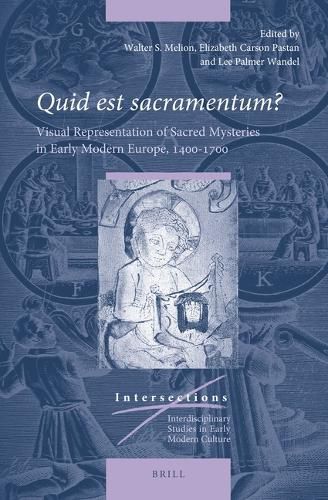Readings Newsletter
Become a Readings Member to make your shopping experience even easier.
Sign in or sign up for free!
You’re not far away from qualifying for FREE standard shipping within Australia
You’ve qualified for FREE standard shipping within Australia
The cart is loading…






‘Quid est sacramentum?’ Visual Representation of Sacred Mysteries in Early Modern Europe, 1400-1700 investigates how sacred mysteries (in Latin, sacramenta or mysteria) were visualized in a wide range of media, including illustrated religious literature such as catechisms, prayerbooks, meditative treatises, and emblem books, produced in Italy, France, and the Low Countries between ca. 1500 and 1700. The contributors ask why the mysteries of faith and, in particular, sacramental mysteries were construed as amenable to processes of representation and figuration, and why the resultant images were thought capable of engaging mortal eyes, minds, and hearts. Mysteries by their very nature appeal to the spirit, rather than to sense or reason, since they operate beyond the limitations of the human faculties; and yet, the visual and literary arts served as vehicles for the dissemination of these mysteries and for prompting reflection upon them.
Contributors: David Areford, AnnMarie Micikas Bridges, Mette Birkedal Bruun, James Clifton, Anna Dlabackova, Wim Francois, Robert Kendrick, Aiden Kumler, Noria Litaker, Walter S. Melion, Lars Cyril Norgaard, Elizabeth Pastan, Donna Sadler, Alexa Sand, Tanya Tiffany, Lee Palmer Wandel, Geert Warner, Bronwen Wilson, and Elliott Wise.
$9.00 standard shipping within Australia
FREE standard shipping within Australia for orders over $100.00
Express & International shipping calculated at checkout
‘Quid est sacramentum?’ Visual Representation of Sacred Mysteries in Early Modern Europe, 1400-1700 investigates how sacred mysteries (in Latin, sacramenta or mysteria) were visualized in a wide range of media, including illustrated religious literature such as catechisms, prayerbooks, meditative treatises, and emblem books, produced in Italy, France, and the Low Countries between ca. 1500 and 1700. The contributors ask why the mysteries of faith and, in particular, sacramental mysteries were construed as amenable to processes of representation and figuration, and why the resultant images were thought capable of engaging mortal eyes, minds, and hearts. Mysteries by their very nature appeal to the spirit, rather than to sense or reason, since they operate beyond the limitations of the human faculties; and yet, the visual and literary arts served as vehicles for the dissemination of these mysteries and for prompting reflection upon them.
Contributors: David Areford, AnnMarie Micikas Bridges, Mette Birkedal Bruun, James Clifton, Anna Dlabackova, Wim Francois, Robert Kendrick, Aiden Kumler, Noria Litaker, Walter S. Melion, Lars Cyril Norgaard, Elizabeth Pastan, Donna Sadler, Alexa Sand, Tanya Tiffany, Lee Palmer Wandel, Geert Warner, Bronwen Wilson, and Elliott Wise.